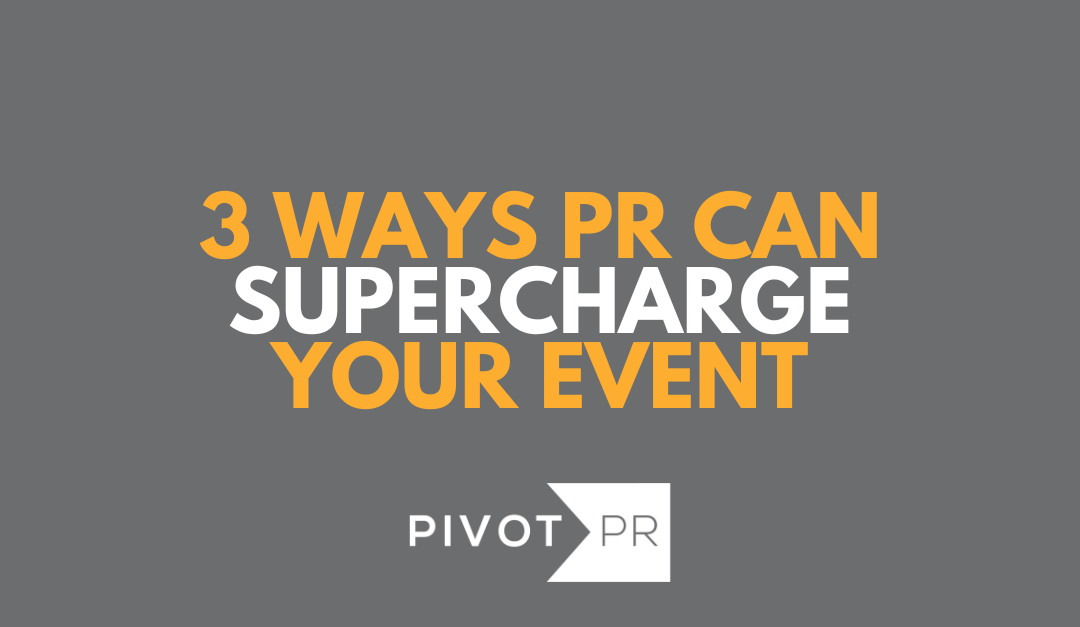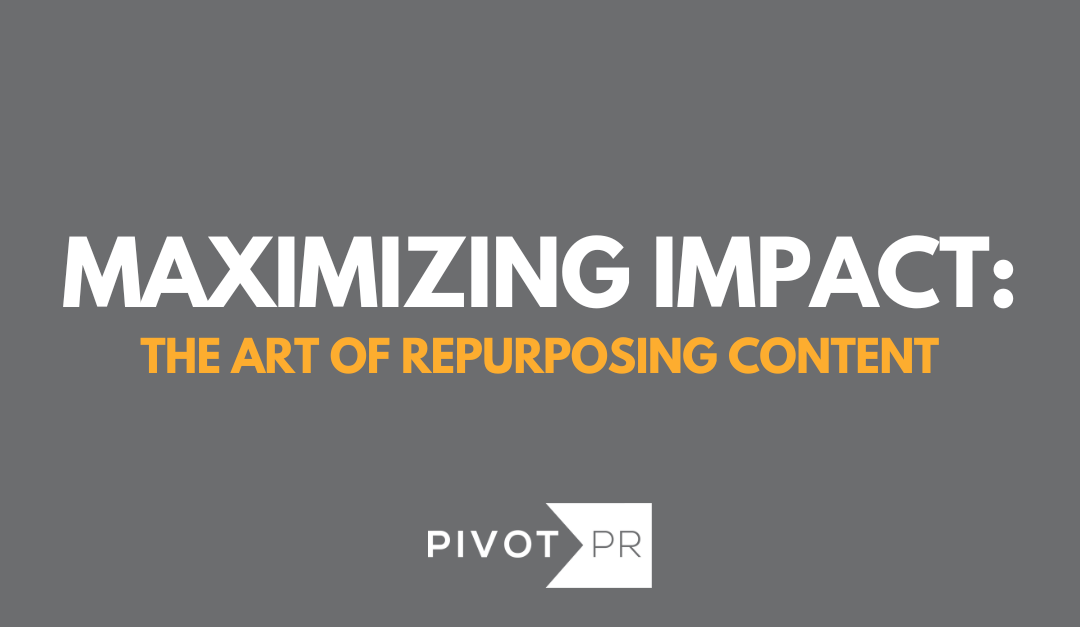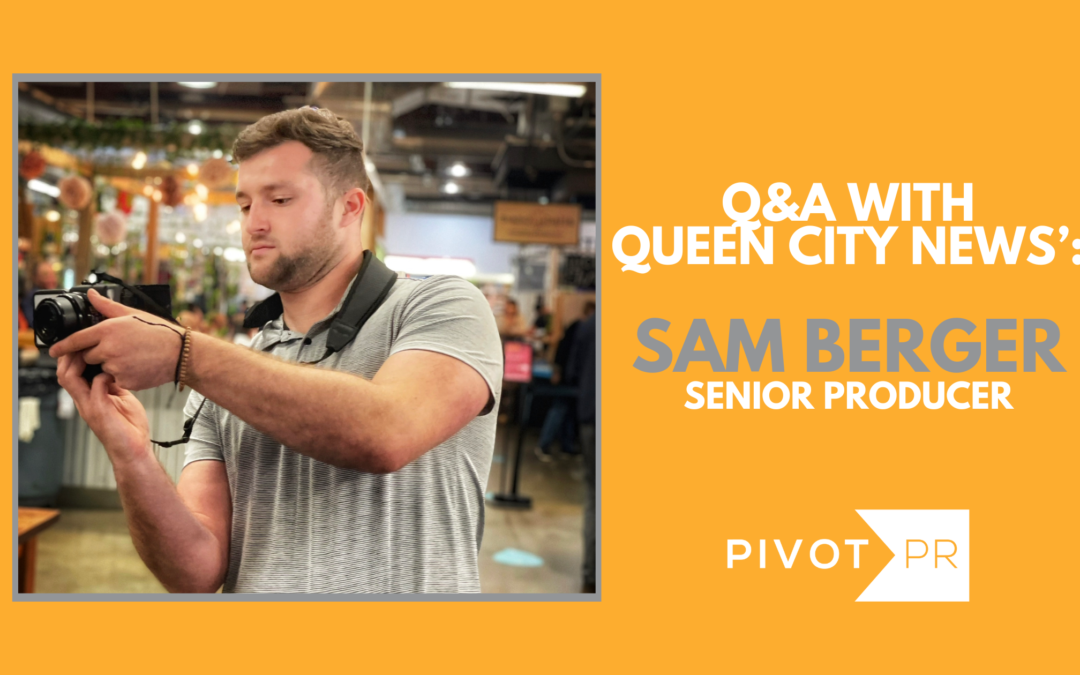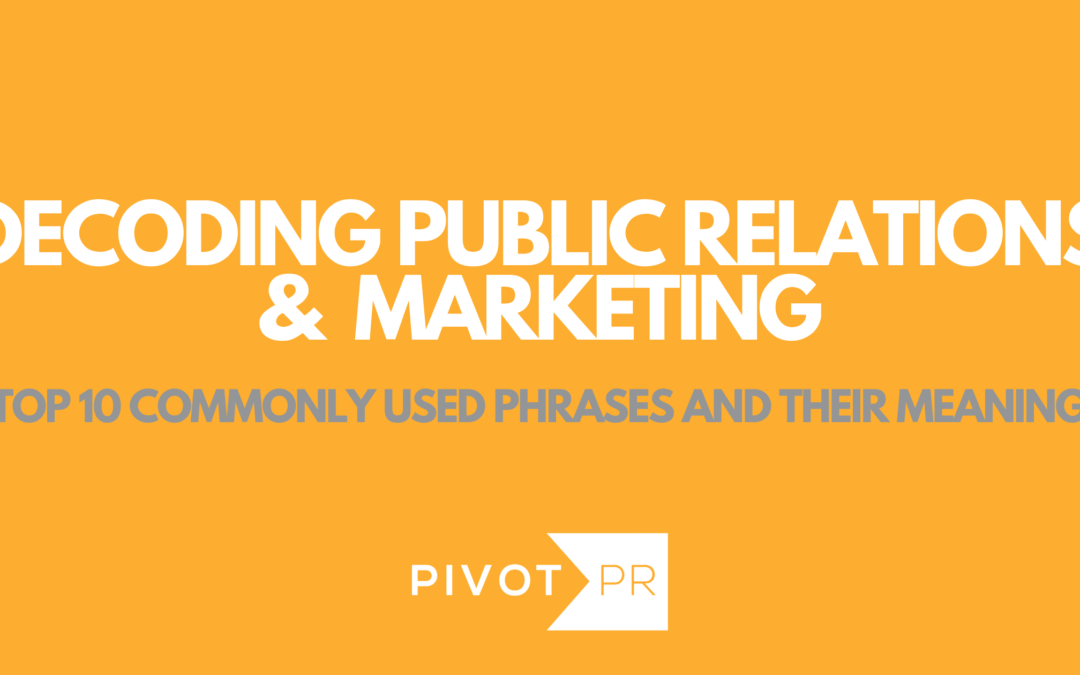
Blog
In the world of events, success isn’t just measured by the number of attendees! In fact, it’s about crafting a branded experience that resonates with your audience, sparks conversation, and leaves a lasting impression. Public relations (PR) is one of the best tools available for the events planning process, no matter your size or industry.
In this blog post, we’re exploring the connection between the two and revealing how PR strategies can transform an event from run-of-the-mill to remarkable. From building excitement before the big day to keeping the buzz alive long after it’s over, the power of PR is undeniable!
1. PR Can Build Pre-Event Anticipation
While sharing your event on your own social platforms is a great place to start, PR provides a much larger awareness boost. Public relations professionals can take your goal and target audience and develop a tailored, strategic plan that utilizes a variety of channels for maximum exposure. These efforts can include, but are not limited to:
- Drafting press releases and securing strategic media coverage and exclusive interview opportunities for digital, print, radio, and beyond.
- Creating social media teaser campaigns, countdowns, and sneak peaks to engage followers and the larger public.
- Identifying macro and/or micro influencer partnerships to help amplify your event to a new audience.
- Conducting neighborhood canvassing to deliver invitations, exclusive promotions, and more.
2. PR Can Enhance the Attendee Experience
There are a lot of moving parts to an event, so allow the experts to handle your guest experience from start to finish! A knowledgeable PR team can provide invaluable insights and guidance drawn from their wealth of event expertise, helping you craft unforgettable moments that leave a lasting impact. Here are a few ways a PR team can foster a VIP experience before, during, and after your event:
- Designing personalized invitations that create anticipation and importance around guest attendance.
- Developing a run of show for the event and/or developing speeches and talking points.
- Recommending partners or interactive experiences like photo booths and live demonstrations to inspire social sharing by guests.
- Incorporating thoughtful touches like gift bags or personalized event elements.
- Serving as an onsite point person for logistical concerns or guest questions.
- Handling post-event guest communications to ensure a positive experience.
3. PR Can Help Sustain Post-Event Momentum
The impact of your event doesn’t end when the lights dim and the guests go home. A PR team understands the importance of sustaining momentum beyond the event. They can maintain engagement by securing post-event coverage, sharing highlights and testimonials, and engaging with attendees on social media. By maximizing post-event exposure, PR helps extend the lifespan of your event’s impact and lays the groundwork for future success.
Planning an event? Reach out to us at [email protected]!
Let us help craft a comprehensive events plan with lasting impact.

Blog
It’s no secret that in the ever-evolving world of digital marketing, content is king. Many brands are struggling to keep up with the increased demand for new and dynamic content, which has not slowed down even as budgets continue to tighten. However, while content might be king, repurposing content is queen.
Let’s explore five creative ways to make your content work harder for you and your budget across the digital landscape.
- Transform Static Images into Slideshow Videos
Your stunning images deserve more than a single static performance! Platforms such as TikTok, Instagram Reels, and even LinkedIn embrace visual storytelling, so transform your static brand images into dynamic, eye-catching slideshow videos. You can also add subtle animations, music, and text overlays for an immersive experience that brings your brand, product, or service to life.
- Breathe New Life into Blog Posts with Micro-Content
Your blog posts are a goldmine of valuable insights. Break them down into bite-sized pieces for social media consumption. Create visually appealing quote graphics, infographics, or short video snippets to best fit the platform. Share these micro-content pieces across platforms to drive traffic back to your blog, catering to different audience preferences.
- Repurpose Long-Form Videos for Short-Form Platforms
Long-form videos don’t have to live in isolation on YouTube or a campaign landing page. Extract the most engaging snippets from the long-form content to share on Instagram, Facebook, or TikTok. Craft teaser videos or highlight reels to generate interest and direct viewers to watch the full video on your YouTube channel or website. Catering to varying attention spans across platforms ensures you reach a broader audience.
- Give Influencer Content a Second Life
Influencer partnerships are valuable assets, so extend their impact by repurposing influencer-created content across your channels. Share snippets on your social media, feature influencer testimonials on your website, and incorporate their content into your email campaigns. This not only maximizes their efforts but also strengthens the authenticity of your brand.
- Create Branded Visuals for Paid Ads
Ensure consistency across your paid advertising efforts by repurposing existing visuals. The images from your latest photoshoot can become the focal point of digital ads, social media campaigns, display ads, and even public relations efforts. A cohesive visual identity reinforces brand recognition and trust, making your campaigns more impactful.
Have questions or need assistance with your content repurposing strategy? Reach out to us at [email protected]!
Let us help craft a plan that resonates across the digital landscape.

Blog
What is your name and where are you from?
My name is Samuel Berger, and I’m a Long Island native who found his way to the Queen City.
How did you end up in Charlotte?
I went to school at SUNY Geneseo and studied communication and political science. Honestly, I did not think broadcast news was where I would find my calling. Aside from eating great food, including some of the best wings ever, I spent my time beat reporting on the Buffalo Bills, or working for government officials. From there I went to Rochester, where I worked at Spectrum News and WHEC, surviving Rochester winters like a champ. If you can handle lake-effect snow, you can handle anything, right?
After that, Kansas City became my home for three years. I was the lead morning show producer and the producer behind the Kansas City Chiefs’ pre-game festivities for the CBS affiliate. That included a highlight of my career, producing a Super Bowl pre-game show with my best friend serving as host, it doesn’t get better than that.
Now, here I am in Charlotte, serving as the Senior Producer at Queen City News. In the Queen City I have truly gotten the best of both worlds: being back near the coast and in a bustling news environment. With Charlotte continuing to grow, no two days are ever alike.
What made you interested in journalism?
That’s an easy question; I have always been interested in people. I believe everyone has a story, and those stories are what make us unique. Through journalism, I have the ability to tell those stories and shine a light on the people that make our communities what they are. It’s that ability to make a difference that drives me.
Each and every day as a journalist, you start with a blank slate, a story, and a deadline, and it’s up to you to make it work, make it interesting, and make a difference.
What kind of news do you find most interesting to report on?
I have a keen interest in human interest stories—they have this incredible ability to connect people on a personal level. Whether it’s exploring unique life experiences, triumphs, or challenges, these stories showcase the diversity of a person. If I can do so through a vehicle like food or sports, both things I am passionate about, it allows me to buy-in that much more.
I am also drawn to complicated issues that deserve a breakdown. There’s a sense of satisfaction in unraveling complex subjects and presenting them in a way that resonates with viewers. At the end of the day it is making sure the viewer gets the information they need and answers to questions. When I can put a challenging subject in layman’s terms and make it digestible for everyone I feel as if I provided a valuable service.
What is the most valuable lesson you have learned so far while working in the journalism industry?
The most valuable lesson I’ve learned while working in the journalism industry is the importance of connections and teamwork. The people you meet and collaborate with are instrumental to success. While I may excel in writing and producing a show, the collaborative effort of editors, directors, anchors, reporters, and the entire newsroom is essential. In other words, the strength of the team directly correlates with the quality of the final product. In journalism, it’s not just about individual skills; it’s about the collective synergy that brings stories to life and delivers impactful content to our audience.
Where do you see yourself in five years?
I envision myself leading a team of creatives in the dynamic world of media. As my longtime news director wisely puts it, I aim to “do interesting stuff” — engaging in innovative and impactful storytelling that captures the audience’s attention. My goal is to make a difference through the stories I tell, ensuring that I am contributing to narratives that truly deserve to be shared. I see myself at the forefront of meaningful projects, utilizing my skills to not only inform but also captivate and connect with viewers on a deeper level.
How can PR pros like us work better with local media?
PR professionals can foster stronger collaboration with local media by immersing themselves in the nuances of a newsroom. Understanding the delicate balance and synergies at play within a news environment is key. By gaining insight into the intricacies of how everything functions together, PR pros can tailor their pitches to align seamlessly with the preferences and requirements of local media.
Moreover, a deep understanding of the angles and story elements needed by local media. This not only gives PR professionals a leg up in effectively communicating their messages but also assists local media outlets in producing compelling and relevant stories.

Blog
Social media is one of the most powerful tools a business can leverage to connect with their audience. How a social media team chooses to manage this tool can significantly impact its effectiveness. One key decision all social managers will face at some point is whether to adopt a centralized or decentralized strategy. Let’s break it down:
The Centralized Approach
Centralized social media means there is one consolidated, central authority or page, typically being the corporate or brand headquarters. This one page will represent all activity in every market, as the “official” page. Having a centralized approach might benefit organizations who are looking for:
- Consistent Branding: Centralization ensures a uniform brand voice, messaging, and visual identity across all platforms. This consistency strengthens brand recognition and credibility.
- Efficient Resource Utilization: It allows for streamlined resource allocation, as a centralized team can manage content, engagement, and strategy for all platforms. This is particularly effective for smaller organizations with limited resources.
- Comprehensive Analytics: Centralized management allows for a more comprehensive analysis of performance metrics across all channels. This aids in better-informed decision-making and strategy refinement.
This is a great option for large brands with a unified identity, financial institutions, or nonprofits.
The Decentralized Approach
Decentralized social media distributes responsibilities and content creation across multiple locations or entities within an organization. This is typically done by various markets or regions having individual social media pages. In this approach, various local/regional branches, departments, or teams have a certain level of control in creating and managing content for their respective social media channels. Having a decentralized approach might benefit organizations who are looking for:
- Localized Content Creation: In a decentralized setup, local or regional teams have the autonomy to create content tailored to their audience’s preferences, culture, and language. This local touch often resonates better with diverse demographics.
- Rapid Response to Regional Needs: Decentralization allows for quicker responses to localized issues or trends, fostering a more agile and responsive approach to regional needs or crises.
- Cultural Relevance and Connection: A decentralized approach facilitates better understanding of local culture and trends, fostering deeper connections with the audience. Not all trends are global, and assuming otherwise might create irrelevant content.
This is a great option for global corporations with regional offices, franchise businesses, or hospitality brands.
When to Localize vs. Decentralize
The organization or brand’s overall goal for their social media channel should play a large role in deciding when to keep social media central, or allow it to be controlled locally. Ask yourself this key question:
What do we want to get out of our social media channels?
If the answer is along the lines of: “we want people to visit us on social media to find out what is going on at each of our many locations,” you might want a decentralized strategy. In this instance, each store or region having its own channel will allow them to highlight events going on in that particular area, helping to increase local engagement.
On the other hand, if your answer is closer to: “the key objective of our social media is to create strong, uniform brand recognition,” a centralized strategy might be the path for you. As opposed to a decentralized strategy, where each market is given the freedom to produce unique content, a centralized strategy is one message, one voice, 24/7.
In summary, the decision to centralize or decentralize social media channels should be guided by your business’s specific needs, audience diversity, and market dynamics. There are pros and cons to having a centralized vs. decentralized strategy, but there is no one correct answer. However, depending on your long-term goals and organizational structure, one might be more suitable for your company over the other.

Blog
Public Relations (PR) and marketing professionals often use specific phrases and terms unique to their industry. Sometimes, these terms can slip into conversations and might leave you feeling confused. In this blog post, we will outline the top 10 commonly used phrases in PR and marketing, providing a clear understanding of their meanings and implications.
- Key Performance Indicator (KPI)
A key performance indicator can also be thought of as a goal, or a target for internal and external teams to aim for. Outlining a clear set of KPIs during a campaign’s planning process will help the team track progress and measure success during and after the activation. KPIs are also a great way to show progress and growth in various areas.
- Media Pitch
A media pitch is a very carefully crafted message that PR professionals use to outline the value of a story, and explain why it should be published to journalists. A pitch aims to capture the journalist’s interest and showcase why the story is newsworthy or relevant. The goal of every pitch is for the story to be published. Read more about how to write a successful media pitch here.
- “On the Wire”
A press release is an official statement issued by an organization to the media. A press release is used to announce big news, an event, product launches, etc. A press release can either be pitched to media individually, or distributed “on the wire”. On the wire refers to PR Newswire, a popular syndication service that publishes the release digitally and pushes it out to hundreds of media outlets. While distributing a release on the wire will help garner more impressions, there is a fee to use the service.
- Unique Visitors per Month (UVM or UVPM)
Unique visitors per month refers to the number of people who visit a website every month. For example, the number of people who visited nytimes.com in a particular month. It can also be thought of or referred to as an “impression”. UVM is a strictly digital metric, and would not be the correct term for print or broadcast media.
- Exclusive
An exclusive is an agreement you might offer a publication, to make them more interested in covering the news. An exclusive promises that publication they will break the news first, as it provides them with exclusive rights to the news.
- Call to Action (CTA)
- A call to action is a direct instruction or request that prompts the audience to take a specific action. It can be as simple as “Shop Now,” “Subscribe,” or “Learn More.” CTAs are strategically placed in marketing materials to guide the audience towards the desired outcome, such as making a purchase, signing up for a newsletter, or engaging with content.
- User Generated Content (UGC)
User generated content refers to assets created by fans or influencers, as opposed to the brand. UGC can be used on a brands social media channels, website pages, or in various printed formats. While some of the pictures might not be quite as polished, it gives a brand a more authentic look that is often appreciated by viewers.
- Crisis Management
Crisis management is the strategic process of handling and mitigating potential or existing crises that may harm an organization’s reputation or operations. It involves preemptive planning, quick decision-making, and effective communication to minimize the impact of the crisis and maintain stakeholder trust. Read more about crisis management here.
- Under Embargo
In PR, having something under embargo is a request the brand makes to the media. It means the information or news provided in a pitch will not be published until a certain date, or until certain conditions have been met. In most cases, an embargo is lifted on a launch day.
- ROI (Return on Investment)
ROI is a metric used to gauge the effectiveness and profitability of a marketing or PR campaign. It measures the financial return generated from the investments made, such as advertising costs, media placement, or events. Calculating ROI helps determine the success of campaigns and can guide future investment decisions.




